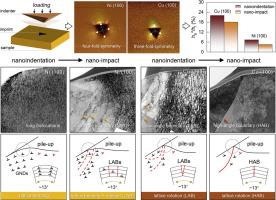FCC金属表面图案化的纳米力学研究:由层错能和应变速率形成
IF 14.3
1区 材料科学
Q1 MATERIALS SCIENCE, MULTIDISCIPLINARY
引用次数: 0
摘要
为了了解应变速率和层错能如何在小长度尺度上调制压痕诱导的表面图案,研究了面心立方单晶的形成机制。在准静态纳米压痕(ε˙ε˙<101 s−1)和高应变率纳米冲击(ε˙ε˙>103 s−1)条件下,Cu(100)和Ni(100)表面成功地获得了不同的层错能。沿压痕方向,Ni(100)压痕表现为四重对称的下沉变形和逐渐堆积,Cu(100)压痕表现为三重对称的急剧堆积。在高冲击应变速率下,整体轮廓保持不变,但高度和范围减小,特别是Ni(100)。基于对应力场特征和不同变形微观结构的分析,揭示了位错驱动表面图案的机制。在此基础上,提出了通过改变层错能和应变速率来调节表面形貌的策略。该研究不仅加深了对小尺度变形行为的理解,而且为开发有效的方法来控制微/纳米纹理的各种应用铺平了道路。本文章由计算机程序翻译,如有差异,请以英文原文为准。

Nanomechanical investigation on FCC metals surface patterning: shaping by stacking fault energy and strain rate
In order to develop an understanding of how strain rate and stacking fault energy modulate indentation-induced surface patterns on small length scales, the formation mechanism on face-centered cubic single crystals was investigated. Different patterns have been successfully obtained on Cu (100) and Ni (100) with distinct stacking fault energy under quasi-static nanoindentation (<101 s−1) and high strain rate nano-impact ( >103 s−1) conditions. Along the imprint, the Ni (100) imprint exhibited sink-in deformation and gradual pile-up with four-fold symmetry, while the Cu (100) displayed sharp pile-up with three-fold symmetry. At the high-impact strain rate, the overall profiles remain unchanged, but the height and range were reduced, particularly pronounced for Ni (100). A dislocation-driven mechanism for surface patterns has been unveiled based on analysis of stress field features as well as distinct deformation microstructures. Furthermore, the strategy of modulating surface patterns by altering stacking fault energy and strain rate was proposed. This study not only deepens the understanding of small-scale deformation behavior but also paves the way for developing effective methods to control micro/nano-sized textures for various applications.
求助全文
通过发布文献求助,成功后即可免费获取论文全文。
去求助
来源期刊

Journal of Materials Science & Technology
工程技术-材料科学:综合
CiteScore
20.00
自引率
11.00%
发文量
995
审稿时长
13 days
期刊介绍:
Journal of Materials Science & Technology strives to promote global collaboration in the field of materials science and technology. It primarily publishes original research papers, invited review articles, letters, research notes, and summaries of scientific achievements. The journal covers a wide range of materials science and technology topics, including metallic materials, inorganic nonmetallic materials, and composite materials.
 求助内容:
求助内容: 应助结果提醒方式:
应助结果提醒方式:


